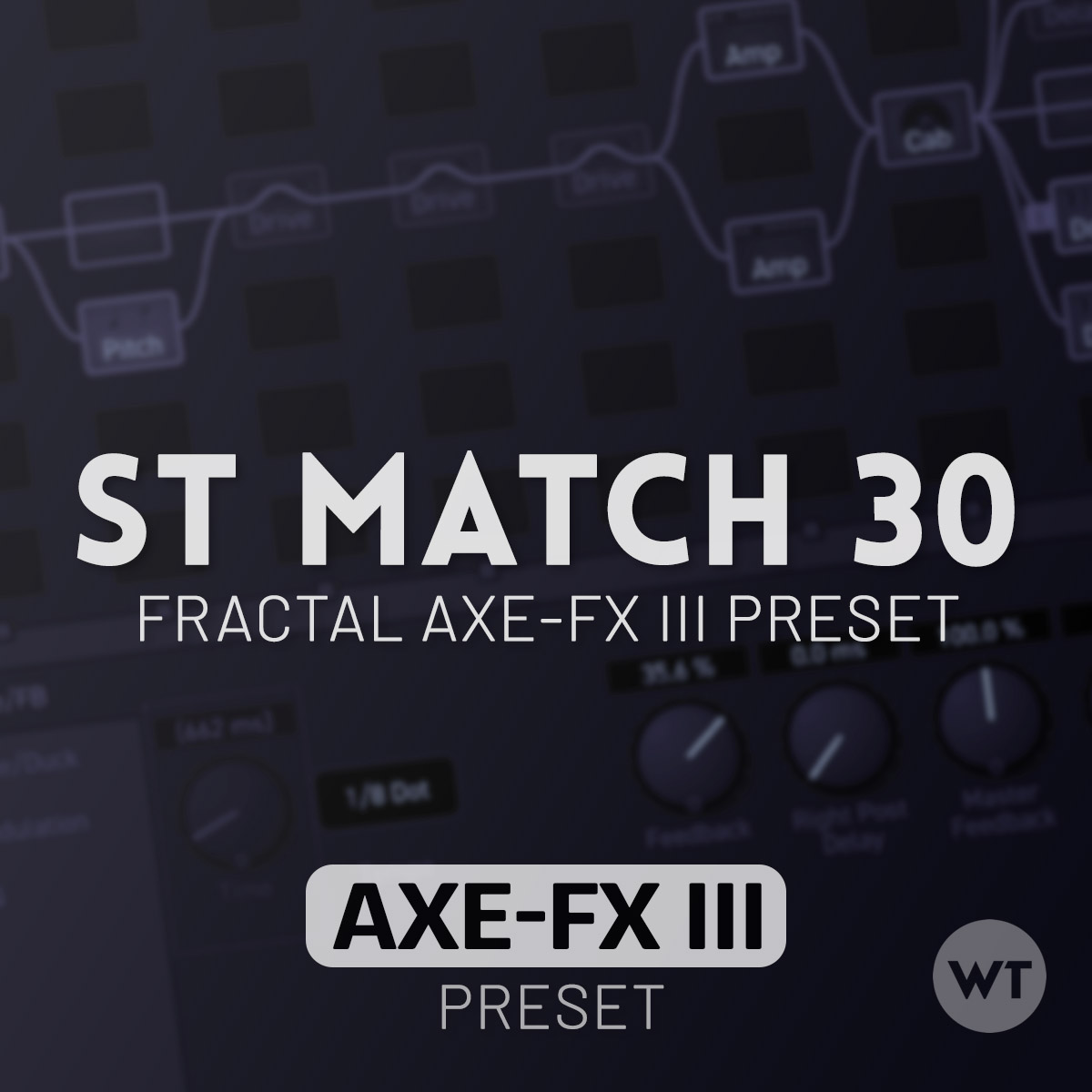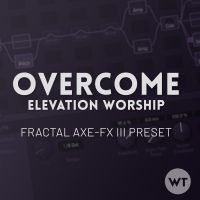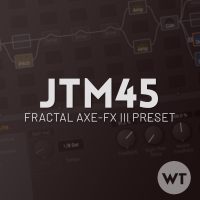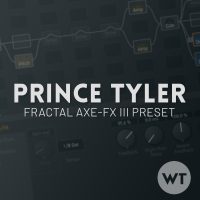Description
IMPORTANT NOTES
- UPDATE YOUR FIRMWARE: Please upgrade the firmware on your Axe-FX III. and make sure to use the latest version of Axe-Edit III before installing this preset. If your firmware is not up to date, this preset may not load.
- EVERYTHING IS STOCK: This preset does not use third party IR’s. If you’d like to experiment with 3rd party IR’s, feel free to do so in the cab block.
- FC FUNCTIONALITY BUILT IN: This preset was built to work with the Fractal FC-12 and an external expression pedal plugged into the ‘Pedal 1’ input. See the Per-Preset overrides and FC assignments below.
- CYGNUS & CNFB UPDATE: We have updated the amp block for the Cygnus & CNFB firmware updates. You’ll need to be running at least firmware 19.06 for this update.
INCUDED PRESETS
- ST MATCH 30 WT (SC)– this preset is voiced for single coils and low-output humbuckers
- ST MATCH 30 WT (HB) – this preset is voiced for more traditional humbuckers
Both presets are the same except for the amp, EQ, and control switch settings. See the ‘Control Switch’ section below for more info.
HOW TO IMPORT THIS PRESET
- Connect your Axe-FX to your computer using a USB Cable
- Download and instal the ‘Axe-Edit III’ app from Fractal
- IMPORT THE PRESETS: In the ‘Axe-Edit III’ app, select ‘Tools’ and ‘Manage Presets’. Drag and drop the folder of presets (or the individual presets) into the browser area, and save them to an open preset slot
SIGNAL FLOW AND EFFECTS
- Input 1 (the Input Noise Gate is turned off to save CPU).
- Compressor 1
- Channel A: JFET Compressor (1176 Style Comp): set to be somewhat transparent, general use comp.
- Channel B: Studio FF Compressor 1: set to be somewhat transparent, general use comp.
- Channel C: Dynamicomp (Dynacomp): Lots of compression and squish.
- Channels D: Optical Compressor (LA-2A style)
- Pitch 1
- Channel A: Dual Chromatic (POG type effect, subtle)
- Channel B: Dual Chromatic (POG, more pronounced)
- Channel C: Crystal Echos (Shimmer)
- Channel D: Classic Whammy (Octave up Whammy – the ‘Control’ parameter is not assigned to an external pedal, so assign the control to an expression pedal and have some fun)
- Drive 1 – First Stage OD
- Channel A: Tone of Kings (low gain)
- Channel B: SSD Preamp
- Channel C: FET Boost (set up to mimic a Klon)
- Channel D: Timothy Up
- Drive 2 – Second Stage OD
- Channel A: Maxoff 808 (mid gain)
- Channel B: Shimmer Drive (big gain)
- Channel C: Tone of Kings (mid gain)
- Channel D: Suhr Riot (Ge) (big gain)
- Vol/Pan 1
- NOTE: The ‘Volume’ parameter is NOT MAPPED. You’ll need to map this parameter to an expression pedal if you’d like to use the volume block
- Chorus 1
- Channel A : Dimension 1
- Channel B: Japan CE-2
- Channel C: Analog Stereo
- Channel D: Stereo Tri-Chorus
- Delay 1: (Quarter and 8th note delays in series)
- Channel A: Stereo Tape (1/8 delay)
- Channel B: Analog Stereo (1/8 delay)
- Channel C: Stereo Tape (1/4 delay)
- Channel D: Analog Stereo (1/4)
- Delay 2: (All dotted eighth note delays)
- Channel A: Deluxe Mind Guy
- Channel B: Stereo Tape
- Channel C: Vintage Digital
- Channel D: Stereo BBD
- Delay 3: (All dual stereo delays)
- Channel A: Deluxe Mind Guy (1/8 and Dotted 8th in stereo)
- Channel B: Stereo Tape (Dotted 8th and Quater in stereo)
- Channel C: Stereo BBD (Quater and Quater Triplet in stereo)
- Channel D: Vintage Digital (Quater and Dotted 8th – huge washy delay for swells)
- Reverb 1: (‘Normal’ verbs in parallel)
- Channel A: London Plate
- Channel B: Recording Studio C
- Channel C: Large Hall
- Channel D: Medium Spring
- Reverb 2: (Big ambient verbs in parallel)
- Channel A: Ice Castle (ambient)
- Channel B: Stratocumulus
- Channel C: Cirrocumulus
- Channel D: Deep Space
- Amp 1:
- Channel A: Matchbox D-30
- Amp 2:
- Channel A: Matchbox D-30
- Cab 1: (only channel A is set up):
- Cab 1: 2×12 Matchbox 160 C (Factory 2, 79)
- Cab 2: 2×12 Matchbox2 -L 121 B AB (Factory 2, 88)
- OUT
SCENES
The following scenes are set up for instant access to various tones:
- Scene 1: CLEAN. Basic clean tone with verb and quarter delay
- Scene 2: DRIVE. Light Drive (Drive 1A)
- Scene 3: DRIVE+. Med Drive (Drive A, Control Switch 1)
- Scene 4: P&W LEAD. Big lead tone with delay and reverb
- Scene 5: AMBI CLEAN. Clean tone with stereo delay (1/4 + 1/8d) and big reverb.
- Scene 6: 80s CLEAN. Clean tone with chorus
- Scene 7: POG LEAD. Like scene 4 but with POG
- Scene 8: SWELLS. Big ambient tones
USAGE NOTES
WET EFFECTS IN FRONT OF THE AMPS
All the wet effects (reverbs and delays) are positioned in front of the amplifiers in this patch. This recreates the experience of using a stereo pedalboard into stereo amps. The character of the reverbs and delays is greatly affected by the amps themselves. This is also why there is no ‘amp gain’ functionality in this patch.
STEREO
Everything after the v volume block is in stereo. If you are running mono, you’ll need to sum your signal to mono before going to FOH (if you only use the Left output, won’t hear some of the delays at all).
The easiest way to make this adjustment is in the ‘Setup’ menu:
- Choose ‘Setup’, and select ‘I/O’
- In OUTPUT 1 CONFIGURATION (choose the physical output you are using), change the ‘Mode’. Select ‘STEREO’ if you are running in stereo. Select ‘’SUM L+R’ if you are running mono. This will convert your output to mono and sum the stereo image. This will also cause all your presets to output in mono, as it is a global setting.
BLOCK CHANNELS
For almost all blocks, we’ve set up multiple channels to give you different options for any given effect. Feel free to experiment and find the sounds you like best. However, not all blocks have all four channels set up – some have just couple, and some only one. See the Signal Flow section above to see what is set up in what channel for any given block.
DRIVES
All drive blocks increase in gain as you go up, so Drive 1 is lower gain than Drive 2, etc. Within each drive block, all four channels are set up to give you different flavors of the same gain structure The main drives we like with this patch are Drive 1A, Drive 2A, and Drive 2B. Every guitar reacts differently with drives (and amps), so it’s good to have options. We’ve chosen our personal favorites within each block and left them in Channel A, but feel free to experiment with your setup to find what you like best.
DELAYS
We’ve used all four channels of three delay blocks (that’s 12 different delays!) . Each delay block runs in parallel with the others so the delays don’t run into each other.
Delay blocks are separated into different delay times. For example, Delay 1 is all quarter or 1/8th note delays. Delay 2 is all dotted 8th noted delays, and Delay 3 is all stereo dual delays. Delay three is a bit different because each channel will give you different rhythmic delays, and Channel D is set to give you a huge wash for swells.
The delays run between the amp and cab to simulate an effects loop in an amp. This means the cabinet will filter the tone of the delays, making them a bit less clean/pristine (we prefer the way they sound this way). Feel free to move them all after the cab (but before the verbs) to experience them in a different way.
REVERB
We’ve set up reverbs the same way as delays – each reverb block contains four versions of the same type of reverb (normal and big).
Reverb blocks 1 and 2 give you ‘normal’ and ambient reverbs respectively.
PER-PRESET MAPPING AND OVERRIDES
This preset integrates with the Fractal FC-12. We’ve set up Per-Preset overrides for both effects and scenes, and we’ve mapped them to Layouts 7 (Perform 1) and 8 (Perform 2). If you have an FC-12, the following assignments should be plug-and-play. Layout 7 will be your scenes and Layout 8 will be individual effects, plus swells.
HERE ARE THE PER-PRESET MAPPINGS AND THE BUTTONS THEY’RE ASSIGNED TO OVERRIDE
PP1: Scene 1 – Layout 7 Button 2
PP2: Scene 2 – Layout 7 Button 3
PP3: Scene 3 – Layout 7 Button 4
PP4: Scene 4 – Layout 7 Button 5
PP5: Scene 5 – Layout 7 Button 8
PP6: Scene 6 – Layout 7 Button 9
PP7: Scene 7 – Layout 7 Button 10
PP8: Scene 8 – Layout 7, Button 11
PP9: Drive 1 – Layout 8, Button 2
PP10: Drive 2 – Layout 8, Button 3
PP11: Delay 1 – Layout 8, Button 8
PP12: Delay 2 – Layout 8, Button 9
PP13: Delay 3 – Layout 8, Button 10
PP14: Reverb 1 – Layout 8, Button 5, ‘Plate Verb’
PP15: Reverb 2: Layout 8, Button 6
PP16: TremPan 1 – Layout 8, Button 12
PP17: Chorus 1 – Layout 8, Button 11
PP18: Pitch 1 – Not assigned to a button
PP19: NOT USED
PP20: Drive 3 – Layout 8, Button 4
PP21: Tap Tempo/Tuner – Layouts 7 & 8, Button 1 (displays BPM for Tap, Press & hold for tuner)
PP22: Layout switch (layouts 7 and 8) – Layouts 7 & 8, Button 7
PP23: Preset Inc +1 – Layout 7, Button 12
PP24: Preset Dec -1 – Layout 7, Button 6
MAKING CHANGES TO THESE ASSIGNMENTS
If you’d like to change any of these assignments (either the Per-Preset Assignments or the Overrides), you can do so in the ‘CONTROLLERS’ menu on the Axe FX III. Press ‘CONTROLLERS’ from the Home screen, then select ‘Per-Preset FC Settings’ and make changes.
If you would like to go back to your default settings for Layouts 7 and 8, you can reset the Overrides from the ‘Overrides’ menu in the ‘Per-Preset-FC Settings’ section.
MAKING ADJUSTMENTS FOR YOUR SETUP
SETTING THE PRESET UP FOR YOUR GUITAR
All guitars are different, so you may want to make changes to suite your playing style and guitar. To adjust the preset for your guitars, the primary controls to adjust would be:
- Input Drive (and/or Input Trim). If the clean sounds from this preset are too dirty, lower the input drive and/or trim. Do the opposite if you want more gain. This preset is meant to be on the edge of breakup at it’s cleanest settings (otherwise the drives won’t stack properly).
- EQ settings (amp block – basic). Once the desired gain staging is set, the next adjustment would be the amp EQ settings.
- Output EQ settings (amp block). The Graphic EQ on the amp block is a great way to make final EQ adjustments. We’ve set it to ‘Post P.A.’, which means the EQ settings will not be affected by the Power Amp section.
ADJUSTING THE OVERALL LEVEL OF THE PRESET
The Axe FX III offers very useful tools to check overall level of individual presets and blocks. In the Output block you can monitor the overall output level. You can also monitor levels of each block individually from the front screen of the Axe FX.
We’ve set this preset up so that the loudest settings peak around 0db (or a bit above). If you’d like to adjust the level up or down (to match it with other presets), we recommend adjusting one of the following:
- Level (amp block – basic). This will adjust the overall level of the preset up/down. Avoid using the ‘Master Volume’ control, as this will change the tone of the amp.
- Level (cab block). This will also adjust the overall level of the preset up/down.
CHANGELOG
Version 1.0 – 2022-04-22








Reviews
There are no reviews yet.